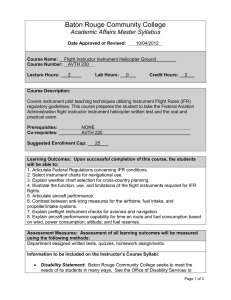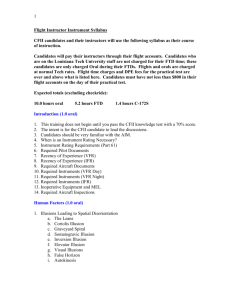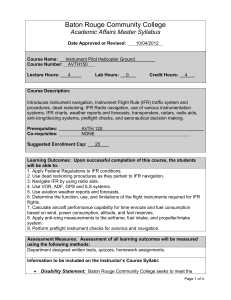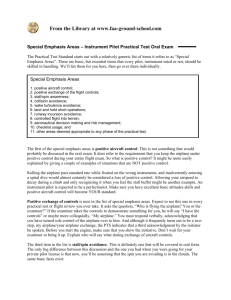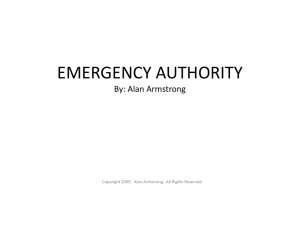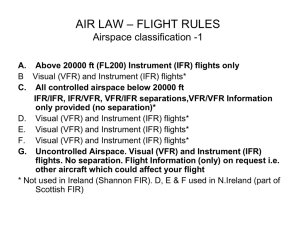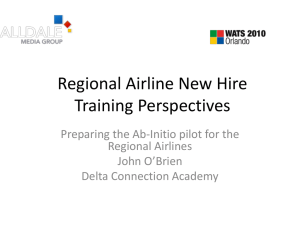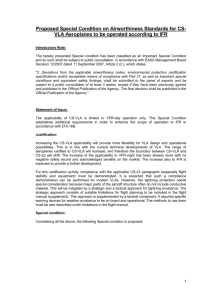2-7-2009 Instrument Rating & IFR Flt. Planning
advertisement
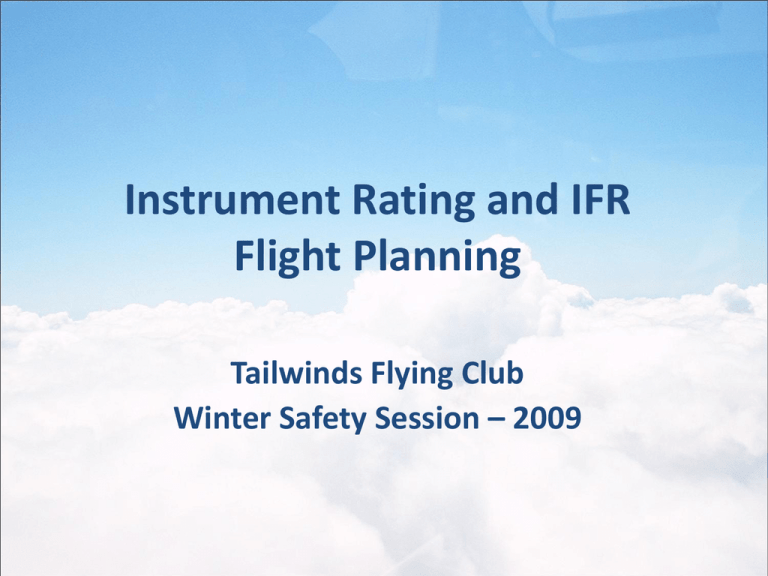
Instrument Rating and IFR Flight Planning Tailwinds Flying Club Winter Safety Session – 2009 Instrument Rating Pilot and Plane Requirements “I fly VFR, why do I need to know IFR requirements?” Low ceilings and visibility, which can catch pilots unaware or lure pilots to fly further, are the most deadly killers. - AOPA Air Safety Foundation VFR into IMC accounted for 87.5 percent of all fatal weather accidents in SEF (single engine fixed gear) aircraft. Most of these accidents could have been avoided had the pilot reversed course at the first recognition of instrument meteorological conditions (IMC), or not departed at all. 2004 Nall Report Instrument Rating You and Tailwinds Flying Club • Safer pilot • Personal life insurance, when available, provides discounts for pilots with IFR ratings • The club encourages continued training and certifications – Club instructors less expensive then typical training schools – Use of club planes Instrument Rating Pilot and Plane Requirements FAR 61.65 (a) (b) (c) (d) (e) GENERAL • Must hold at least a current private pilot certificate • Be able to read, speak, write the English language • Receive and log ground training on the aeronautical knowledge areas • Receive a logbook endorsement from an authorized instructor certifying the pilot is ready to take the required knowledge test • Receive and log flight training on the areas of operation • Endorsement from an authorized instructor that the pilot is prepared to take the required practical test • Pass the required practical and knowledge tests The pilot must meet the aeronautical knowledge and flight proficiency as required by parts (b) (c) Instrument Rating Pilot and Plane Requirements FAR 61.65 • 50 hours cross-country flight time as PIC • 40 hours of actual or simulated instrument time on the areas of operation per FAR 61.65 (d) (i) (ii) (iii) – 15 hours instrument flight training from an authorized instructor in the aircraft category for which the instrument rating is sought; – 3 hours of instrument training that is appropriate to the instrument rating sought from an authorized instructor in preparation for the practical test within 60 days preceding the date of the test; – Instrument training on cross-country flight procedures that includes at least one cross-country flight in an airplane that is performed under IFR, and consists of • A distance of at least 250 nm along airways or ATC-directed routing • Instrument approach at each airport • Three different kinds of approaches with the use of navigation systems • Part (e) relates to the use of flight simulators or flight training device Instrument Rating Pilot and Plane Requirements FAR 91.201 (b) (c) (d) (b) Visual-flight rules (day) – Instruments required • AI, Altimeter, Magnetic DI, Tachometer, Oil pressure, Temperature gauge, Manifold pressure, fuel, landing gear (if retractable), safety belts (shoulder harness for front seats), documents (AROW), anti-collision lights (c) Visual-flight rules (night) • Instruments and equipment specified for day VFR plus; position lights, landing light, source of electrical energy (d) Instrument flight rules • Instruments and equipment specified above plus; two-way radio, gyroscopic rate-of-turn indicator, slip-skid indicator, adjustable barometric pressure sensitive altimeter, clock (display hour, minutes, and seconds), generator/alternator, gyroscopic pitch and bank indicator, gyroscopic direction indicator Instrument Rating Club Airplanes • All of the club airplanes are instrument rated • Garmin GNS 430 – – – – Flight plans Current approach procedures Nearest airports includes approaches Frequency lists (departure, enroute, or arrival) • Auto-pilot – Archer – Arrow – Six IFR Weather Weather Effects Weather effects you need to understand • • • • • • Icing Snow showers Thunderstorms Temperature inversions Fast-moving fronts producing high winds Fog Be aware of changes in the weather before and during your flight Listen to your inner voice and know your minimums IFR Weather Weather Sources Preflight • Online – AOPA Weather (www.AOPA.com) – DTN – Meteorlogix (http://aviation.dtn.com) – ADDS – (http://adds.aviationweat her.noaa.gov) • FSS (800.992.7433) • FBO – Valters Aviation (www.valtersaviation.com) • ASOS (STP – 651.298.1410) In flight • • • • • • • FSS – 122.2 AWOS (21D – 120.075) ATIS – (STP – 118.35) Enroute: 122.0 Tower ATC HIWAS (MSP Gopher 117.3) IFR Flight Planning 21D – Lake Elmo Airport Approved approaches and arrival charts IFR Flight Planning What are the take-off minimums for Lake Elmo Airport? IFR Flight Planning Destination and Alternate Airports Destination Airport Alternate • • • • • • • • • • • • Approach charts Frequencies Topography Obstructions Runway(s) visual aids Towered / non-towered How far – 45 min. Runway(s) Obstructions Weather ATIS / AWOS / ASOS Frequencies Make sure the alternate is a good choice before you go there IFR Flight Planning IFR Check List 1. 2. 3. 4. 5. 6. 7. 8. Charts, plates, clipboard (kneeboard), 2 pencils Copy ATIS – AWOS Altimeter within 75 feet DG set Check fluid level in magnetic compass Attitude indicator set VSI showing ‘0’ rate Pitot heat check – ammeter deflected 9. 10. 11. 12. 13. 14. 15. Marker beacons on and tested – lights, speaker, test GPS/VORs currently tested and logged Set GPS/VOR frequencies ADF test – set to 0 degrees, swing needle, listen Alternate static air check for deflections in instruments Check time and set Call for taxi and clearance IFR Training Instruction and Practice • • • • • • Use the club’s instructors Fly with/as a safety pilot Take online courses Use flight simulators Fly practice approaches Practice IFR flight planning Thanks! Questions?
